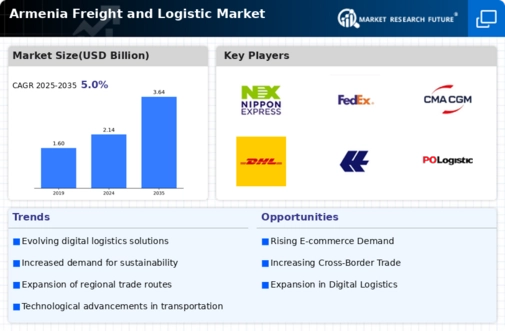Growing E-Commerce Sector
The rapid expansion of the e-commerce sector significantly influences the Global Armenia Freight and Logistic Market Industry. As consumer preferences shift towards online shopping, the demand for efficient logistics solutions has surged. This trend is evident in the increasing volume of parcels and goods requiring timely delivery. The logistics sector is adapting to these changes by implementing advanced technologies and optimizing supply chain processes. The projected compound annual growth rate of 4.96% from 2025 to 2035 indicates a robust response to the evolving market dynamics driven by e-commerce. Consequently, logistics providers are likely to enhance their capabilities to meet the rising expectations of consumers.
Market Growth Projections
The Global Armenia Freight and Logistic Market Industry is on a growth trajectory, with projections indicating a market value of 2.14 USD Billion in 2024 and an anticipated increase to 3.64 USD Billion by 2035. This growth reflects the increasing demand for logistics services driven by various factors, including e-commerce expansion and infrastructure improvements. The compound annual growth rate of 4.96% from 2025 to 2035 suggests a robust outlook for the industry. These projections highlight the potential for investment and development within the logistics sector, positioning Armenia as a competitive player in the global logistics landscape.
Strategic Geographic Location
The Global Armenia Freight and Logistic Market Industry benefits from Armenia's strategic geographic position at the crossroads of Europe and Asia. This location facilitates access to major trade routes, enhancing the country's role as a logistics hub. The proximity to key markets in the Eurasian Economic Union and the Middle East allows for efficient transportation and distribution of goods. As a result, Armenia's logistics sector is poised for growth, with projections indicating a market value of 2.14 USD Billion in 2024. This geographic advantage is likely to attract foreign investment and stimulate the development of infrastructure, further solidifying Armenia's position in the global logistics landscape.
Regulatory Framework Improvements
Improvements in the regulatory framework are pivotal for the Global Armenia Freight and Logistic Market Industry. The Armenian government is working to streamline customs procedures and reduce bureaucratic hurdles, which can impede the efficiency of logistics operations. By simplifying regulations and enhancing transparency, the government aims to create a more conducive environment for logistics businesses. These efforts are expected to attract both domestic and foreign investments, fostering growth in the sector. As the market evolves, these regulatory enhancements may contribute to the anticipated growth trajectory, with the industry projected to reach 3.64 USD Billion by 2035.
Infrastructure Development Initiatives
Ongoing infrastructure development initiatives play a crucial role in the Global Armenia Freight and Logistic Market Industry. The Armenian government is actively investing in modernizing transport networks, including roads, railways, and airports. These improvements aim to enhance connectivity and reduce transit times, making logistics operations more efficient. For instance, the construction of new highways and the upgrade of existing rail lines are expected to facilitate smoother freight movement. With a projected market growth to 3.64 USD Billion by 2035, these infrastructure enhancements are likely to support the increasing demand for logistics services and improve Armenia's competitiveness in the global market.
Technological Advancements in Logistics
Technological advancements are reshaping the Global Armenia Freight and Logistic Market Industry. The adoption of innovative technologies such as automation, artificial intelligence, and data analytics is enhancing operational efficiency and decision-making processes within logistics companies. These technologies enable better tracking of shipments, optimization of routes, and improved inventory management. As logistics providers increasingly leverage these advancements, they can respond more effectively to market demands. The integration of technology is likely to support the projected growth of the market, with an expected value of 2.14 USD Billion in 2024 and a compound annual growth rate of 4.96% from 2025 to 2035.












